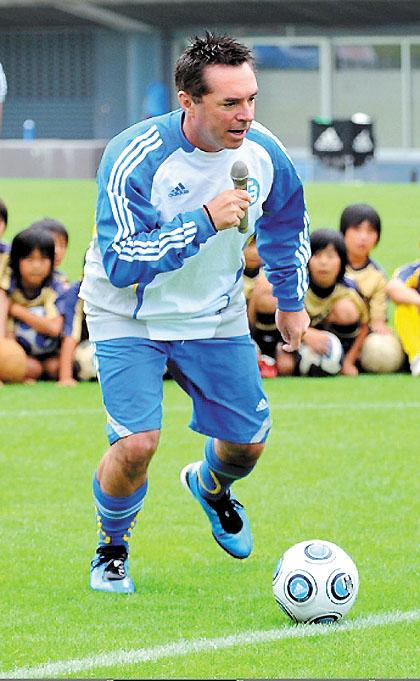American Tom Byer…In Japan They Call Him Tomsan.

By Ray Alley
In the Land of the Rising Sun, the sun shines brightly on Japanese soccer.
Japan’s women’s national team is the defending World Cup champions, beating the #1 ranked U.S. in the final. They finished second this summer to the U.S. for the Olympic gold medal. The men’s national team is on the rise.
Credit a grassroots player development program for producing players who are now competing with the best in the world.
At the center of the improvement in soccer in Japan over the past decade is an American.
To most within the greater soccer community in the United States, the name Tom Byer doesn’t attract much recognition.
In Japan, he has been the preacher of player development for the last 25 years. The message he has been selling is develop the technical abilities of players at a young age. Give them the tools to play the game, and the confidence to succeed.
He’s done it through thousands of clinics, both for players and for local coaches. He’s done it on television, with videos, with soccer comic books.
In Japan, he is best known by a single name — Tomsan.
“I introduced a technical teaching program, and for 13 yeas I was on national TV every morning preaching the gospel of ball skills,” said Byer in a recent New York Times article by Jack Bell.
“I played a big role in this generation of kids playing soccer. It’s difficult to pat myself on the back, but I definitely think I was a game-changer. It’s all about technique and ball mastery.”
Byer grew up playing soccer in upstate New York. He was the Mid-Hudson Player of the Year at Roundout Valley HS, and began his collegiate career with two seasons at SUNY-Ulster where he received his Associate degree in Liberal Arts.
The South Florida Connection
He signed to play his final two seasons at the University of Baltimore, but decided he’d rather finish his collegiate career at the USF. He sat out a year, and then walked on at South Florida. He earned a starting spot for Coach Dan Holcomb’s Bulls, playing from 1982-83.
Ironically, the University of Baltimore dropped its intercollegiate athletic program in 1983.
“I signed a letter of intent for the Univesity oif Baltimore, but decided I did not want to attend there,” Byer recalled. “My dream was to attend the University of South Florida since I was a boy. I lived in St. Petersburg for only one year as a small boy, but my U12 club team practiced at USF and my coach (Norbert Muller) was a player there. So I fell in love with the school.”
He started at right back on the Bulls team that lost 2-1 to Duke in the NCAA D-I tournament, but scored USF’s only goal.
“Roy Wegerle assisted on my goa,” recalled Byer. He would go on to have a wonderful professional cvareer in the UK, MLS and World Cup ’94 (with the U.S. MNT). My former Ulster teammate, Joe Ulrich, was captain of Duyke and the time, and he would later go on to win the Herman Award.”
After his senior year, Byer attracted the attention of the Tampa Bay Rowdies of the old NASL, who drafted him. But by then the league was in full decline and folded shortly thereafter.
After exploring pro opportunities in England, he signed with Hitachi FC (currently named Kashiwa Reysol) in Japan’s J-League. He became the first American to play in Asia.
It was when he retired as a player, in 1993, that he began coaching in Japan. As director of Coerver Coaching Asia he introduced technique development at the grassroots level. By the time he left Coerver in 2007, he had established more than 60 schools in Japan.
Thus began the television show and DVDs through his own school called T3.
Basic to his philosophy of player development is the belief that in order to make the top players better you must also make the worst players better. Thus, you create a more competitive base that will better the individuals.
The same is true from a team standpoint. If the top teams are challenged by better competition because of the improve play of opponents, the top teams will have to also improve to remain the top teams.
Internationally, we see that happening with the improved level of play by national teams, not just Japan, but also France, Brazil, Canada, Mexico, Great Britian, Colombia and a number of African nations.
New Job In China
So what do you do for an encore after success in Japan. You move into a new job as the head technical consultant for the China School of Football. It’s a program established in 90 cities with over 3,000 schools. The mission is to resurrect a program that has fallen greatly in recent years.
China’s WNT was once a world power. China hosted the first women’s world championship tournament in 1991 and finished second to the U.S. in the 1999 FIFA Women’s World Cup.
China’s MNT enjoyed some success a decade or so ago, but has already been eliminated in qualifying for the 2014 World Cup in Brazil.
With a population of over 3000 million people under the age of 14, Byer will seek to improve the level of play and the player pool from the ground up.
He is still living in Japan with his wife Midori, and their two sons, Kaito (6) and Sho (3). In time, his new opportunity may lead to a family move to China, but for now he operates from Japan.
Southern Soccer Scene contacted Byer at his home in Tokoyo. He spoke of what he’s accomplished and what the future holds. He spoke of successes and of challenges.
As an American, he has a unique perspective of soccer in the U.S. and in two Asian countries, Japan and China, that are quite different.
